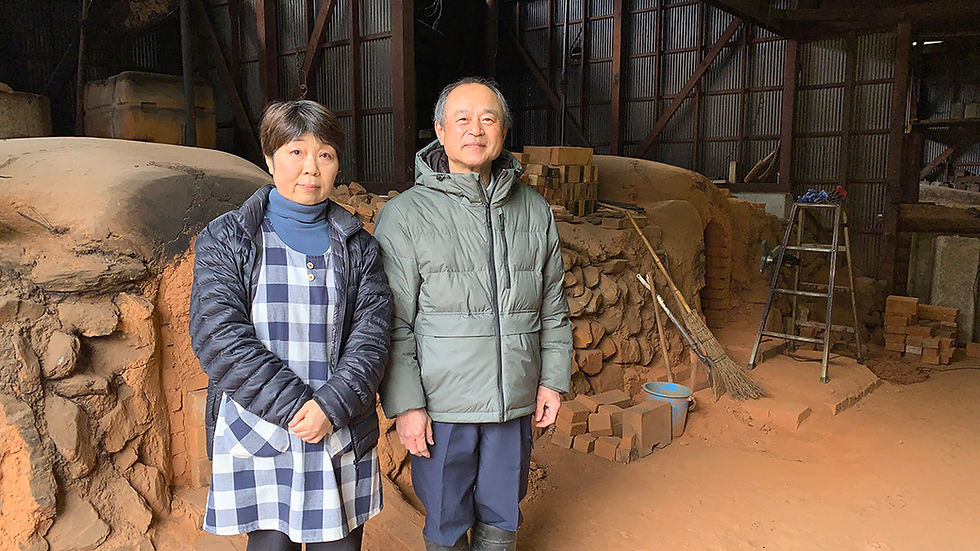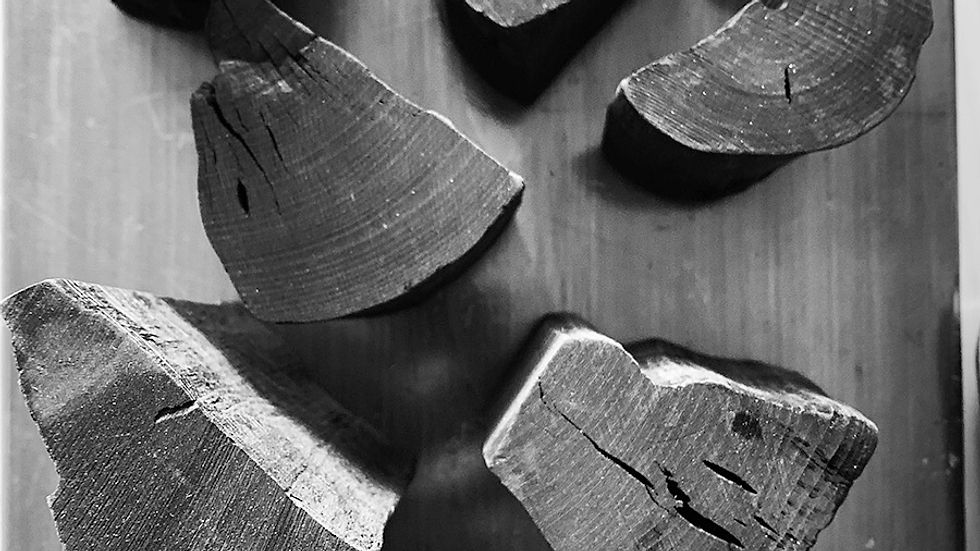Inside the Story of Suruga Polishing Charcoal for Kintsugi & Lacquer Craft: Why Artisans Say There’s No Substitute
- mikster
- Jun 30
- 7 min read
Updated: Jul 19
As part of our “Tools for Real Kintsugi” series, we are introducing the essential yet often misunderstood tools used in authentic urushi-based kintsugi and Japanese lacquer craft. We begin with one of the most irreplaceable tools: Suruga abrasive charcoal (commonly referred to as kintsugi polishing charcoal), hand-crafted by one of Japan’s last remaining specialists.
So no, Japanese binchotan or BBQ charcoal won’t do. Japanese charcoal is not one-size-fits-all. Each type is defined by use, species, and tradition. Suruga charcoal (and three others) is made as a polishing tool—not to burn.
A Hidden Legacy in Japanese Charcoal-Making

Charcoal has been part of Japan’s material culture for centuries. From tea ceremonies and sword-smithing to calligraphy and lacquer craft, Japan’s charcoal-making evolved not towards industrialization, but towards specialization. Today, these charcoals are still handcrafted in small batches by regional artisans, not factories.
Different types of artisanal charcoal have evolved to suit different needs:
Binchotan for slow-burning, low-smoke grilling.
Take-sumi (bamboo charcoal) for purification or as pen ink.
Sumi ink stick made with charcoal soot for traditional painting & calligraphy.
Abrasive/polishing charcoal: This lesser-known type is specifically developed to sand and polish urushi lacquer and other fine surfaces, including metals.
Abrasive charcoal (or polishing charcoal) is primarily used for sanding and polishing lacquerware. It has eventually found its way into the kintsugi pottery repair craft, which is a branch of lacquer craft. Charcoal made from different woods is designated for either sanding the primer or polishing the top coat of lacquerware or decorative gold/silver powder in maki-e art.
The cream of the crop is called Suruga charcoal. It was developed by charcoal makers during the Meiji period (1868-1912) to serve the Suruga lacquerware production in Shizuoka Prefecture. Later, it was perfected in Fukui Prefecture using Japan's native woods. So Suruga is not the name of the tree, but the craft region it was made to serve.
Meet the Maker: Takeo Kidoguchi, Guardian of Abrasive Charcoal Making
Today, only two artisans still produce traditional Suruga charcoal. One of them is Mr. Takeo Kidoguchi in Fukui, a region known for traditional lacquerware, maki-e craft, and artisanal charcoal making.

As a young man, Kidoguchi came across the path of charcoal-making. In 1994, he visited the late Charcoal Master Higashi Asataro in Fukui and expressed his desire to follow the deshi-iri (Japanese apprenticeship system). It took him six months of persistent pleading to finally be accepted as an apprentice.
He trained for four years making various types of charcoals under the cooperative they established together. However, it would take another ten years of trials and failures before he could produce Suruga charcoal that met the high standards of lacquer artisans in Wajima. “I would bring my charcoals to Wajima and let the craftsmen trial and critique. Their standards were extremely high. I remember returning home with urushi rash from sitting on traditional tatami cushions at their studios. After years of rejection and refinement, I was finally able to produce something that the artisans approved—a tool that helped them create beautiful lacquerware."
Now, with 30 years of experience, Kidoguchi's work has won multiple honors. He is recognized as a Designated Guardian of Craft (Abrasive Charcoal-Making). His charcoal is used not only in lacquer work but also in industries requiring chemical-free and precision polishing, such as refined metal finishes. Since abrasive charcoals can only be made in small batches, orders are now reserved a year in advance.
What Makes Charcoal Artisanal and Precious?
The Three-Year Making Process
Each spring, the Kidoguchi husband-and-wife team begins scouting the nearby mountains in Fukui. From afar, he looks for subtle signs: patches of white blossoms signaling the seasonal readiness of the Nihon aburagiri tree (specie: vernicia), a type of tung tree native to Japan.
Once the white flowers are spotted, the couple hikes into the steep forests to scout and mark 30 trees with optimal traits: straight trunks, maturity, health, and clear surroundings. The ideal Japanese tung trees for producing Suruga charcoal should be between 30 to 50 years old. Finding the right trees requires trained eyes and decades of experience.
After time-consuming alignments with landowners and forestry officials for permission to log, the next challenge involves mapping a route inside the forest to safely reach and harvest each tree. This also includes setting up temporary rail tracks to haul logs down hazardous slopes by hand. Logs are chopped in the mountain into smaller pieces to fit their tiny transport truck. All the labor-intensive work is done solely by the husband-and-wife team.
In addition to Suruga charcoal, the Kidoguchis also log various woods from the back mountains to create other types of polishing charcoal. With their kiln and woodshop surrounded by mountains, raw material is always within their reach.
Kiln Firing
Once harvested, the wood is debarked and naturally air-dried for two years. The logs are then carefully loaded and fired in brick kilns built by Kidoguchi.
Firing charcoal is weather-dependent. Once started, the kiln must be manned to reach 350°C for three continuous days. Charcoal-making involves timing the processes of carbonization, steaming, and oxidation inside the kiln. Mr. Kidoguchi relies on his senses: eyes, ears, and smell. There is no technical equipment—only an artisan's experience interpreting subtle cues such as the density, scent, and color of the smoke, air circulation, humidity, and the sound of the fire.
Visitors are usually not allowed. “The work demands absolute focus,” he says. “Distraction can ruin the batch, and all our hard work could go to waste.”
What Makes Suruga Charcoal Different?

The firing process removes water content and impurities, changing the wood structure to create many microscopic holes, like a sponge. Unlike fuel charcoal, abrasive charcoal is very lightweight with a hollow sound when tapped.
After firing, the volume of wood reduces by half. Of that amount, only half qualifies as sellable abrasive charcoal, selected by purity, weight, grain pattern, and sound.
"Lacquer artisans always hand-pick their own charcoal pieces. They inspect each chunk of my charcoal to find what fits their practices and work," Kidoguchi explained. This process relies heavily on intuition built from years of experience and knowledge that is felt, not taught or shared.
Modern synthetic substitutes like sandpaper or crystal whetstones are compacted micro-abrasive particles. During use, they break down, and loose particles can scratch delicate lacquer and porcelain surfaces.
In contrast, abrasive charcoal works by removing and capturing loose particles while burnishing the surface. The natural tree fiber smoothens the lacquered surface without leaving marks and molds itself to the contours of the surface. Kidoguchi produces three main types of abrasive charcoal (tung tree, magnolia, camellia), each with unique properties suitable for different stages of the complex lacquering process.
"Of course, there are cost-efficient synthetic alternatives like sandpaper and whetstones, but even with technological advances, none can replace the abrasive performance of artisanal charcoal. I hope more people know about premium quality charcoal as tools. As long as my customers demand them, I will keep producing and passing down my skills." Consider this as testament to Japanese ancient material intelligence.
"Precious, Not Expensive"
Suruga charcoal is priced around $250 per 1 kg. Kidoguchi’s wife quietly reflects, “It concerns us when we hear remarks like 'expensive.' We hope our charcoal will be recognized as 'worthy.'”
In fact, these polishing charcoals are low-yield and reflect three years of manual, dedicated hard work by the Kidoguchi couple: scouting the mountains, logging and hauling the trees, natural drying, manning the kilns, sorting, and packing. Each piece of charcoal is the result of intensive manual labor and a lifetime of knowledge. If you come from countries where charcoals are mass-produced in factories, it may be difficult to comprehend the valued culture and history behind artisanal charcoal. Even when Kidoguchi fires two to three times a year, low yield means limited availability. With his existing artisan and craft supply partners, orders are placed in advance, and everyone has to wait for a year to receive Kidoguchi's charcoal.
Kidoguchi remembers taking a leap of faith in the charcoal industry with his wife and his one-year-old son. Life was difficult as an apprentice. He produced various types of charcoal for sale while honing his skills in artisanal charcoals. Only after a decade did he master the craft and build trust with users and the craft industry.
He continues this work out of gratitude—to his wife, relatives, the artisans who provided critical feedback, wholesalers, and the community that supported and believed in him.
For Serious Kintsugi Learners: A Note on Integrity
As kintsugi has become globally popular, so has the rise of misleading information. Some shops market binchotan or generic “Japanese charcoal” as polishing tools for kintsugi. These charcoal products were made for other uses and won’t deliver proper performance; they can even damage craft projects.
Conversely, Suruga and other abrasive charcoals were originally developed as tools for lacquer craft and refined over generations.
If you wish to experience polishing charcoal for your kintsugi craft, we now offer limited quantities of specific Japan artisanal abrasive charcoal in our kintsugi material shop. The quantity is capped so as not to disrupt supplies to professional lacquer artisans in Japan. This is an indispensable tool for many. Be a responsible learner and help protect this traditional Japanese craft.
As you polish your next kintsugi project, remember: The silky smooth surface and shine you create began in a forest, endured through fire, and arrived in your hands because of Mr. Kidoguchi's dedication and persistent effort.
Coming Next: How to Use Polishing Charcoal in Kintsugi
Stay tuned! Subscribe or follow us to be notified. Next, we will showcase the different types of sanding and polishing charcoal and other tools for kintsugi, exploring how to use them effectively.





Comments